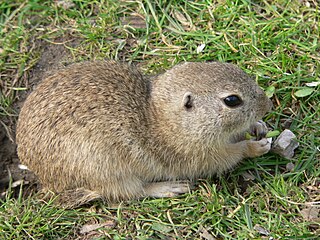
The ground squirrels are members of the squirrel family of rodents (Sciuridae), which generally live on or in the ground, rather than trees. The term is most often used for the medium-sized ground squirrels, as the larger ones are more commonly known as marmots or prairie dogs, while the smaller and less bushy-tailed ground squirrels tend to be known as chipmunks. Together, they make up the "marmot tribe" of squirrels, Marmotini, and the large and mainly ground squirrel subfamily Xerinae, and containing six living genera. Well-known members of this largely Holarctic group are the marmots (Marmota), including the American groundhog, the chipmunks, the susliks (Spermophilus), and the prairie dogs (Cynomys). They are highly variable in size and habitus, but most are remarkably able to rise up on their hind legs and stand fully erect comfortably for prolonged periods. They also tend to be far more gregarious than other squirrels, and many live in colonies with complex social structures. Most Marmotini are rather short-tailed and large squirrels. At up to 8 kg (18 lb) or more, certain marmots are the heaviest squirrels.

The northern Idaho ground squirrel is a species of the largest genus of ground squirrels. This species and the Southern Idaho ground squirrel were previously considered conspecific, together called the Idaho ground squirrel.

Spermophilus is a genus of ground squirrels in the family Sciuridae (rodents). As traditionally defined the genus was very species-rich, ranging through Europe, Asia and North America, but this arrangement was found to be paraphyletic to the certainly distinct prairie dogs, marmots, and antelope squirrels. As a consequence, all the former Spermophilus species of North America have been moved to other genera, leaving the European and Asian species as true Spermophilus.

Richardson's ground squirrel, also known as the dakrat or flickertail, is a North American ground squirrel in the genus Urocitellus. Like a number of other ground squirrels, they are sometimes called prairie dogs or gophers, though the latter name belongs more strictly to the pocket gophers of family Geomyidae, and the former to members of the genus Cynomys.

The Washington ground squirrel is a squirrel found in the Pacific Northwest, in the states of Washington and Oregon of the Northwestern United States.
Flickertail may refer to:

The Arctic ground squirrel is a species of ground squirrel native to the Arctic and Subarctic of North America and Asia. People in Alaska, particularly around the Aleutians, refer to them as "parka" squirrels, most likely because their pelt is good for the ruff on parkas and for clothing.

Belding's ground squirrel, also called pot gut, sage rat or picket-pin, is a squirrel that lives on mountains in the western United States. In California, it often is found at 6,500 to 11,800 feet (2,000–3,600 m) in meadows between Lake Tahoe and Kings Canyon. This species is not of conservation concern, and its range includes some protected areas.

The Uinta ground squirrel, commonly called a Potgut in northern Utah, is a species of rodent native to the western United States.
Merriam's ground squirrel is a species of rodent in the family Sciuridae. It occurs in the states of Idaho, Nevada, and Oregon in the United States.

The Columbian ground squirrel is a species of rodent common in certain regions of Canada and the northwestern United States. It is the second largest member of the genus Urocitellus, which is part of the tribe Marmotini, along with marmots, chipmunks, prairie dogs, and other holarctic ground squirrels. They are stout, with short dense fur, which is characteristically tawny across the bridge of the nose. Social encounters often are initiated with kissing behavior and the most common activity above ground is standing at attention. Residing in mountainous terrain and high plains in northern latitudes, they hibernate most of the year in burrows, which may be used for many years. They are emaciated when emerging in the spring. These long periods of torpor earned the squirrels the moniker "Seven Sleepers", since the rests last around seven months. The Columbian ground squirrel came to the attention of the scientific community through writings produced by Lewis and Clark, while 21st century molecular genetics has more finely illuminated its ties with other close relatives.

The Wyoming ground squirrel is a species of rodents in the family Sciuridae.
The Piute ground squirrel is a species of rodent in the family Sciuridae.

The long-tailed ground squirrel or Eversmann's souslik is a species of rodent in the squirrel family Sciuridae. It is found in China, Kazakhstan, Mongolia, and Russia.

Urocitellus is a genus of ground squirrels. They were previously believed to belong to the much larger genus Spermophilus, but DNA sequencing of the cytochrome b gene showed that this group was paraphyletic to the prairie dogs and marmots, and could therefore no longer be retained as a single genus. As a result, Urocitellus is now considered as a genus in its own right.

The southern Idaho ground squirrel is a species of the largest genus of ground squirrels. This species and the Northern Idaho ground squirrel were previously considered conspecific, together called the Idaho ground squirrel.












